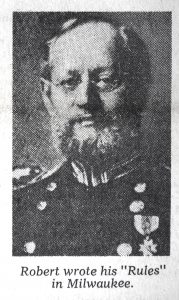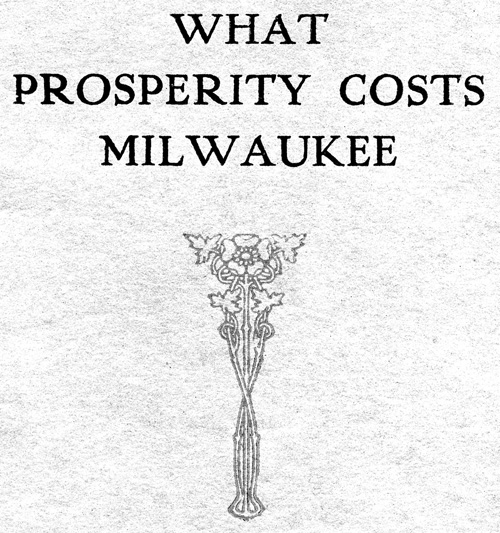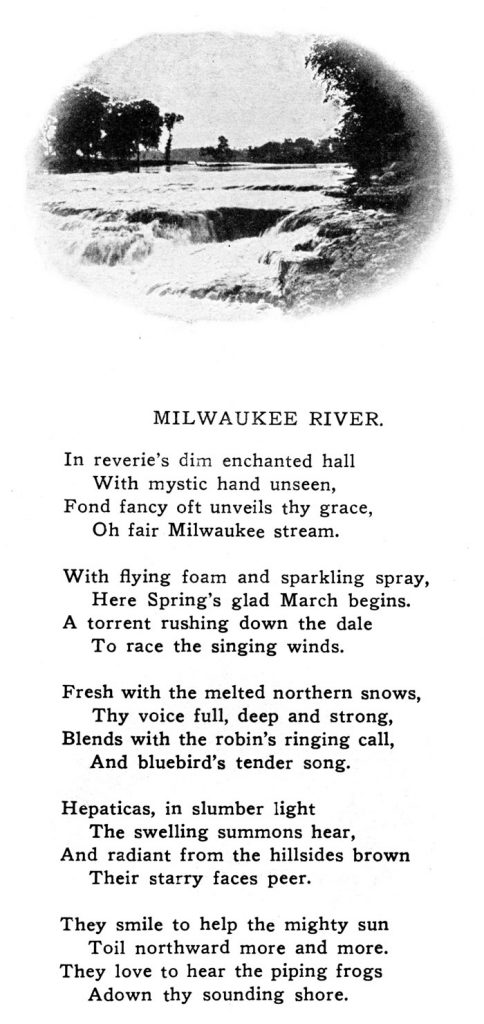
One hundred years ago on August 2, 1920, the Socialist newspaper, “The Milwaukee Leader” wrote an article about a push by C.B. Whitnall, member of the Metropolitan Park Commission, to have municipal control of land along the rivers to improve health conditions and property values. He wanted the land north of the North Avenue dam protected by city-owned parks. His ideas eventually became a reality through his efforts and even today the parks that line the river basin provide an amazing recreational spot and have helped to improve the river so that it is much cleaner than it once was.
The following text was from a publication he put together in 1920 called “What Prosperity Costs Milwaukee.” It is interesting to see that he was ahead of his time with some of the current issues we still face about public responsibility and trying to save taxes by not spending for things that will save taxes in the future. It required a lot of forethought and will for him to do the right thing. This park land Whitnall helped create continues to improve the quality of life for nearly a hundred years.
“We read in the history of the decline of empires or nations, and we marvel at the ignorance and apathy of the people that brought about the decline. Yet our citizens today do not blame themselves for like conditions in Milwaukee.
“If some one should prove to us that in the last 20 years Milwaukee, through her own shortsightedness, has suffered a loss in property and human life equal to the property value of Racine, we would at once realize that a serious state of affairs existed. Something like that has really occurred. We find that although the city keeps increasing in size and number, a deplorable loss constantly takes place. Growing under those circumstances, it is like trying to fill a barrel which leaks.
“By the time you get it full you have used barrels of water. Labor in Milwaukee is being taxed directly or indirectly for filling a leaking barrel, whereas an additional expenditure properly applied would stop the leakage. Yet many of our citizens and non-partisan newspapers say we cannot afford to mend the barrel until after we have filled it. The filling is a vital necessity. The repairing in the public opinion is not. This is the penny wise and pound foolish economy now being advocated by the “keep down the tax” economist.
Perhaps the greatest decline in property value during the time stated has been north of the Menomonee River, paralleling Grand Avenue. Every real estate dealer has continual inquiry from residents of this locality for trades, seeking homes along the lake shore. Why? Because Grand Avenue is ruined, while the lake shore property is sanitary and attractive. We have a special tax of $25,000 a year that the park department is obliged to use for improvement of the lake shore. This is equal to an annual interest paying on $625,000 that never can be reduced. Although desirable, it does not promote the sanitation of the afflicted locality from which they are fleeing, or prevent further development of devitalizing conditions in other sections of the city. These are some of the palatial homes on Grand Avenue lately put on the declining market for want of support-Alexander Mitchell, now the Deutscher Club, James Kneeland, three Plankinton homesteads, Captain Pabst’s residence, the Schandein residence, and several others that can be had for far less than the cost.
People who can afford buildings of such size and quality will no longer endure the objectionable conditions which have quietly and steadily grown upon the neighborhood through lack of foresight. A conservative estimate of the depreciation is five million dollars. This is a net loss to the city of $100,000 a year in taxes. This unusual loss to the city might have been prevented by proper care exercised in time. However, we should not blame former administrations for what they may not have been able to comprehend or anticipate. But with this deplorable state of affairs in plain view, how can we expect to be forgiven for not making every effort to prevent a like loss in other localities? Surely here is a condition in which history should not repeat itself.
The next step downward has already begun. Building operations under disguise of improvements are being made to crowd more people on a lot so as to maintain as far as possible the normal income. As the crowding increases the desirability lessens, and unless the city as a whole recognizes its responsibility, slum territories will be the inevitable followers of what was at one time the pride of the west side. Sanitary conditions are growing worse all the time. The waste of humanity, however, will continue to spread beyond such sources of pestilence. They cannot be confined within the boundary line of landlords’ possessions. The chain is no stronger than its weakest link, and our city’s health, physique and moral condition is vitiated as a whole by such cancerous spots.
Although we have suffered this loss of approximating $100,000 a year on the Grand Avenue depreciation, we are, nevertheless, obliged to do, at much greater expense, that which should have been done to prevent this loss. Had this territory been taken by the city and managed as is now proposed to manage the shores of upper Milwaukee River, the Kinnickinnic River and the upper Menomonee River, the city would have received in enhanced taxes an amount equal to its investment, and at the same time, it would have protected the individua1 investors from loss or hardship.
It is now incumbent upon us to prevent the slums of the Fourth Ward from spreading westward to meet the growth of Piggsville in the now reminiscent river at the Blue Mound viaduct. While those who are able to move to more desirable quarters are, as individuals, blame1ess for caring for themselves, the city must not shrink from its responsibility for the protection of the health and property of rich and poor alike. It is imperative that the nuisance of the lower Menomonee be cured, but all of this desirable work cannot be done at once. The cure costs at least four times as much as the prevention. Then will not the public interest be served best by an energetic effort to prevent a repetition of such wasteful circumstances?
Take a walk along the Menomonee Valley from Piggsville to Wauwatosa, and see how surely all that property along Vliet Street to Wauwatosa and west of Washington park will be vitiated in the same way. Likewise the natural residence area along the Blue Mound Road is destined to the same fate if not properly platted, and the natural contour of the land, with its drainage, preserved. What has taken place along the banks of the lower Menomonee has also been repeated on a smaller scale all over the city. What ward of the city has not suffered more or less by such a conflict of interests?”
Anyone that has held a meeting to official standards most likely has followed Robert’s Rules of Order. They even have a website! This has been in book form since 1873 when it was written by Maj. Henry Martyn Robert. Major Robert was a South Carolinian who came to Milwaukee after the Civil War when he was assigned to the Army Corps of Engineers to oversee harbor improvements. Leave it to the long, Milwaukee winters to inspire one to write, even if it isn’t poetry but an extensive rulebook.

Below is an article from the Milwaukee Journal of April 5, 1970 telling the story of Robert’s Rules:
Milwaukee’s Top Seller
The most famous book that ever came out of Milwaukee has just appeared in a new revision. The book is “Robert’s Rules of Order,” and the revision is described by its publisher— Scott, Foresman — as the first major one in 55 years.
It was not quite a century ago that Maj. Henry Martyn Robert of the title began to write out some thoughts on parliamentary procedure. After the Civil War, Robert had come to Milwaukee as an Army engineer concerned with the defense and the improvement of the harbors and light houses of Lake Michigan. He composed his little handbook, he subsequently related, in the winter of 1873-’74 when he “had a few weeks to spare” from his maritime duties.
The Lieutenant Was Embarrassed
The decision to write a simple and practical guide to parliamentary principles grew out of an embarrassment he had suffered during the war. Though he was a South Carolinian by birth, he fought on the Union side.
In 1863, half a dozen years out of West Point, young Lt. Robert was called upon to act as chairman of a meeting of citizens in New Bedford, Mass. The New Bedford whalers were much exercised by Confederate raids on their far ranging ships, and the townspeople gathered in a Baptist church to discuss the matter.
“I plunged in,” Robert wrote later, “trusting that the assembly would behave itself.” On the contrary, the sharp Yankees gave the callow gavel wielder a hard time. Mortified, he set out to learn as much as he could about parliamentary order and put it down briefly and clearly in a single book.
Like many an author before and since, he found publishers less enthusiastic about his project than he was. The big New York house of Appleton promptly rejected the manuscript. Finally he had 4,000 copies “ready printed” at his expense by the Milwaukee job shop of Burdick & Armitage. He talked the Chicago publishing house of C. S. Griggs into having them bound, also at his expense.
About 1,000 copies were given to legislators and others in and out of politics. They found them useful, recommended them to friends, and “Robert’s Rules of Order” was on its way. Its original title was “Pocket Manual of Rules of Order for Deliberative Assembles,” but the publisher printed the other name as a subtitle on the jacket, and that was the one that stuck. The author left Milwaukee in 1878.
2,600,000 Copies and No Paperbacks
Through the years, says the present publisher, the manual has sold well over 2,600,000 copies in seven earlier editions. The new edition has had a first printing of 100,000.
Though Robert died in 1923 (he was then a retired brigadier general), the Robert family has retained a connection with the book and its fortunes. The eighth, current edition was prepared by Mrs. Sarah Corbin Robert, the general’s daughter-in-law, and her son, Henry Martyn Robert III. They had the assistance of James W. Cleary, president of San Fernando State College in California, and William Evans, a Baltimore lawyer and parliamentarian. About three-quarters of the book has been rewritten, so that in its present form it is about twice as long as it was in its previous, 75th anniversary edition.
If a paperback edition had been sanctioned, the sale of the book by this time might be astronomical. But the Robert heirs have insisted that it have hard covers.
Said Henry Martyn Robert III the other day:
“If you use the book as you should, a paperback edition would be worn out in no time.”
More information can be found here.
Thanks for reading!

